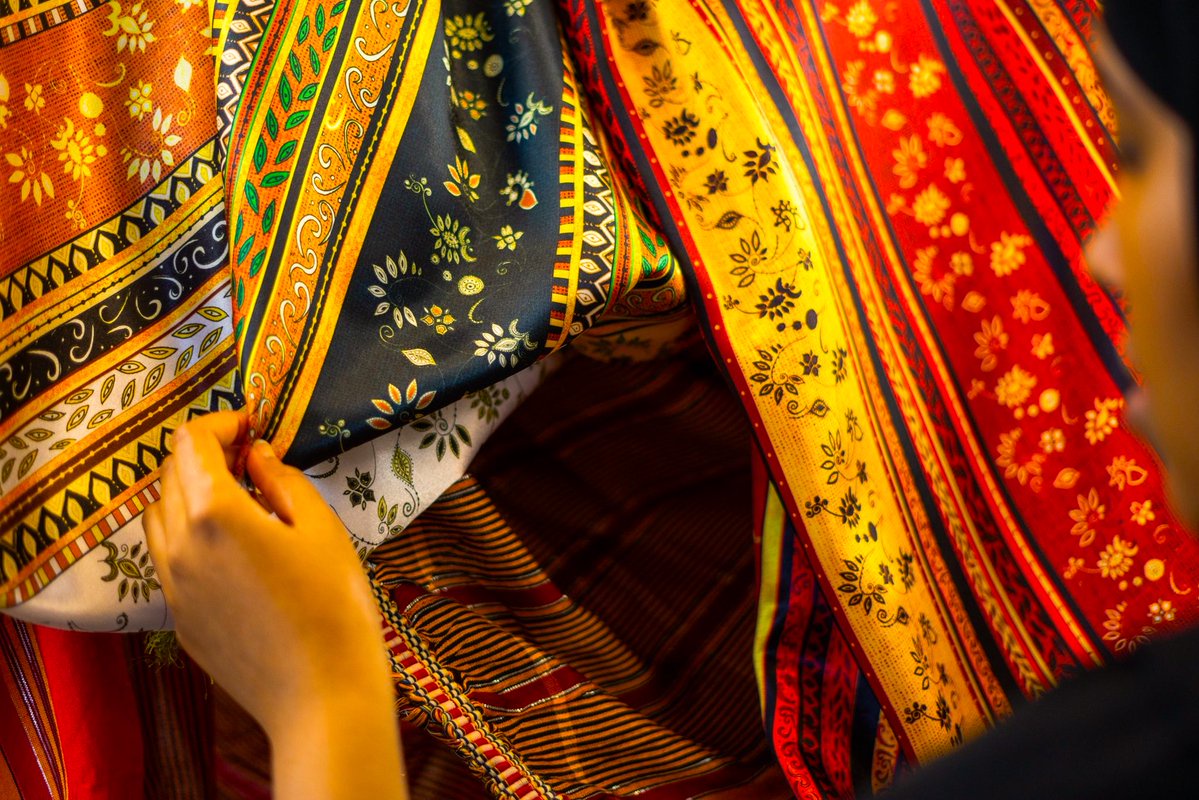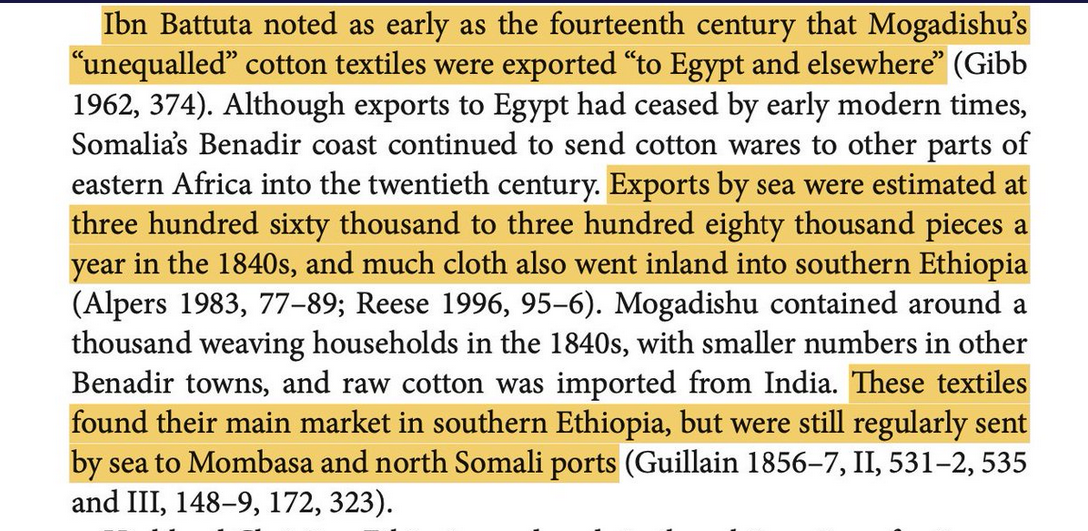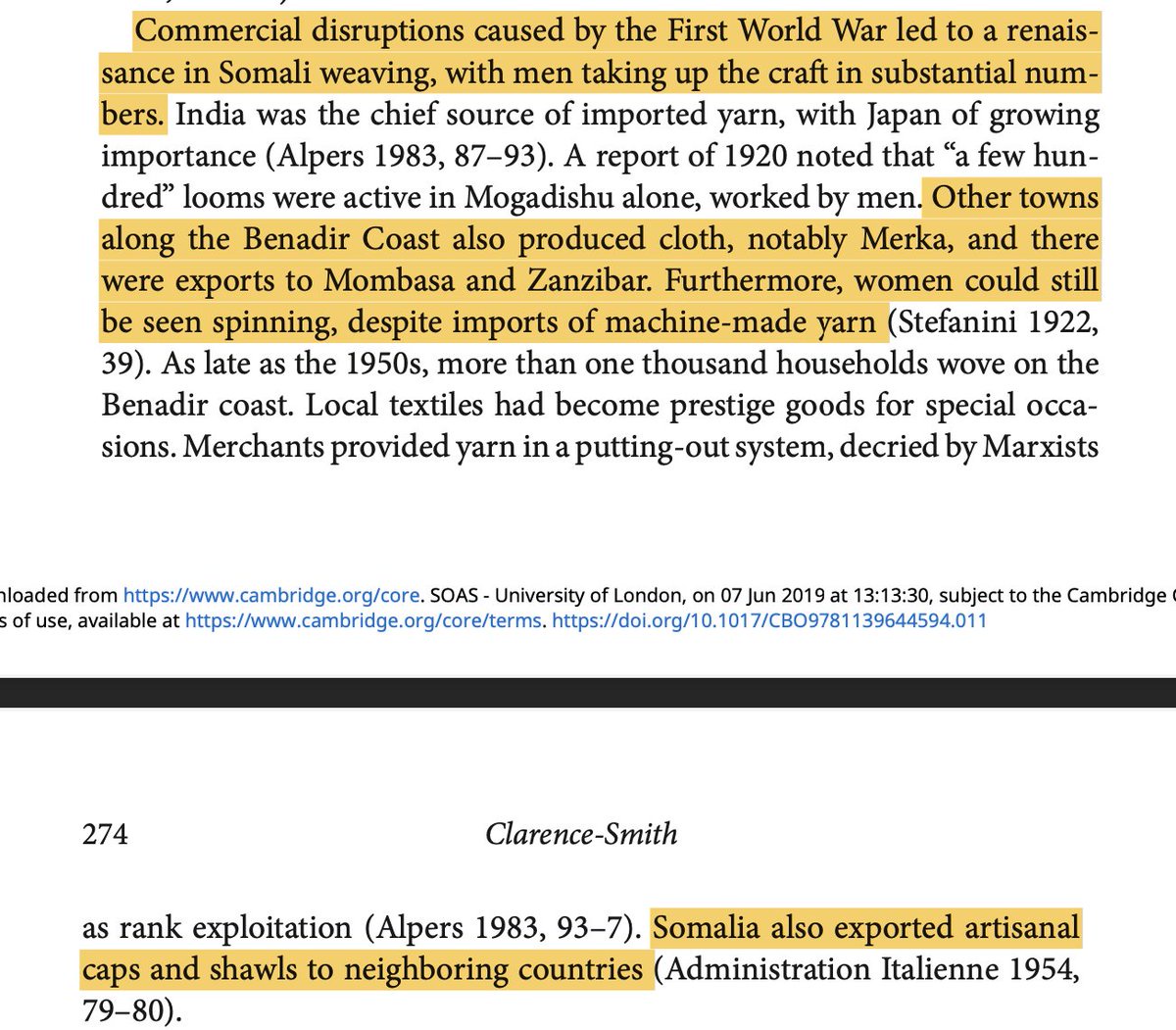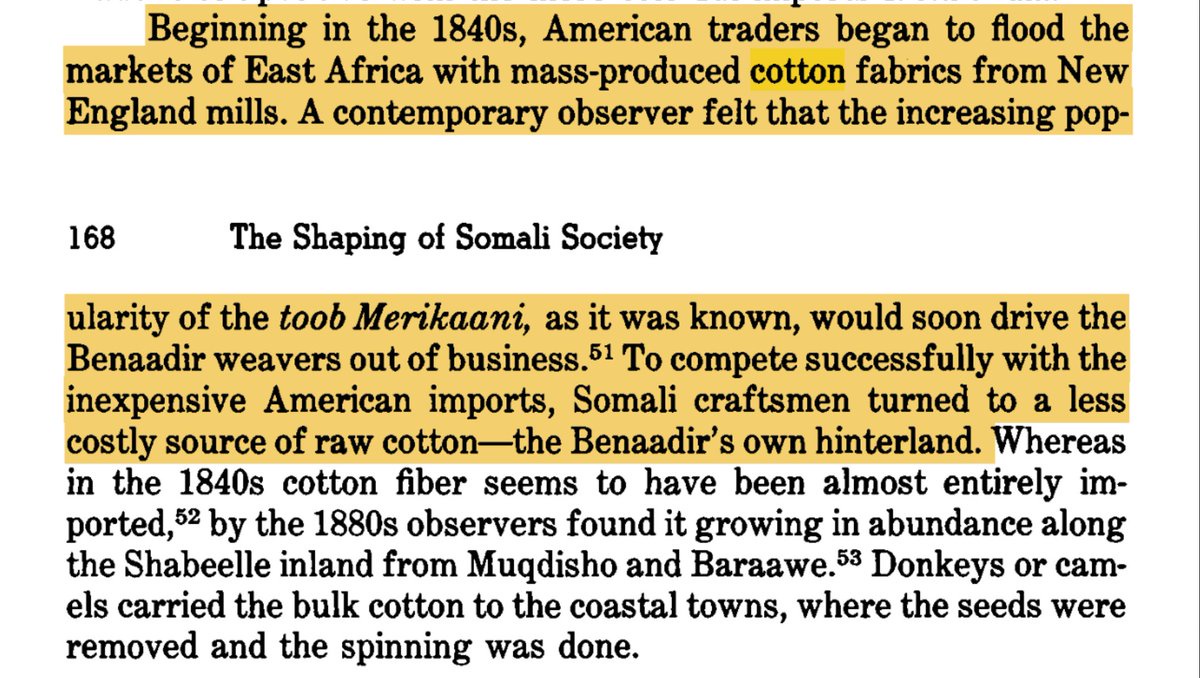How about population? How would somalis go about industrialising in that period when our total population didnt even break the threshold of 1 Million if we compare it to the japanese pre industrialisation their population was at 30 Million, A Healthy number to implement industrialisation and growth.I looked at the ref to it and it says Sokoto was a slave society. I doubt an economy largely based on mostly slave export to be that advanced.
Somali societies had more diversified trade developments and networks.
For example our textile industry was larger it was the one of the most dominant in Africa, especially in East Africa and they got incredibly wealthy from it continued throughout the 1800s until the early 1900s, exporting finished garments, shawls and artisanal caps.



It managed to even stay competitive against American textile exports:

And this is just southern Somalia alone, Harar textiles and tailored garments probably compounded that several folds i am looking more into.
You are using an out of date browser. It may not display this or other websites correctly.
You should upgrade or use an alternative browser.
You should upgrade or use an alternative browser.
liberal ethio-philia phenomenon deep dive
- Thread starter hayran
- Start date
Our population was bigger than 1 million, at least according to @Idilinaa that said, you don't need a huge population to industrialize. Scandinavian countries back in the 19th century had tiny populations, barely 3 million but they were all able to industrializeHow about population? How would somalis go about industrialising in that period when our total population didnt even break the threshold of 1 Million if we compare it to the japanese pre industrialisation their population was at 30 Million, A Healthy number to implement industrialisation and growth.
Our population was very spread out as well thoug over a large landmass.Our population was bigger than 1 million, at least according to @Idilinaa that said, you don't need a huge population to industrialize. Scandinavian countries back in the 19th century had tiny populations, barely 3 million but they were all able to industrialize
hayran
Ride The Lightning
He makes a fair point. A large and well fed population is crucial to industrialisation.Our population was bigger than 1 million, at least according to @Idilinaa that said, you don't need a huge population to industrialize. Scandinavian countries back in the 19th century had tiny populations, barely 3 million but they were all able to industrialize
Scandinavia punches above its weight due to an OP geography that allowed them to cultivate a dominating maritime culture.
Somalia could easily feed itself with fish like the nordics, but there’s also a land and population issue. Somalia is way too sparsely populated, the nordics have a dense population because half their land is uninhabitable
Yeah but populations would still be concentrated in key cities and areas with tons of commercial activity.Our population was very spread out as well thoug over a large landmass.
How would the clans be united and who would have been likely to lead the industrialisation? @IdilinaaYeah but populations would still be concentrated in key cities and areas with tons of commercial activity.
Idilinaa
VIP
He makes a fair point. A large and well fed population is crucial to industrialisation.
Scandinavia punches above its weight due to an OP geography that allowed them to cultivate a dominating maritime culture.
Somalia could easily feed itself with fish like the nordics, but there’s also a land and population issue. Somalia is way too sparsely populated, the nordics have a dense population because half their land is uninhabitable
Most of Scandinavia is long winters where they couldn't cultivate and had to store food, most of their economy like in Norway was lumber exports. They had to import food.
Somalia on the other hand was exporting more grain and food surpluses than most of the East Africa, they not only fed entire cities but also help feed neighboring countries
In the past it was usually not just meat exports or even livestock. It was also other agricultural products.
Somalia was the main supplier of grain and other products to Southern Arabia and Yemen. Which basically dubbed southern-central part of Somalia as the ''Grain Coast supplier of Southern Arabia'' from the mid 1800s

In the medieval times 1500s Northern Somalia used to produce a lot of food of all types, especially various agricultural products and the export of it went to supply Aden and other parts of Arabia to qoute ''A port of much provisions for Aden, and all parts of Arabia'' . So yeah you are right in a way when you say it was the ''breadbasket''
Same goes for the Harar uplands many cities in mid-late 1800s balooned and trippled/doubled in size because of an increase in agricultural production.
The nordics don't have dense population.
The northern parts of the country are sparsely populated due to the climatic conditions. Overall, the population density is only 14.3 people per km², making Norway one of the most sparsely populated countries in the world. Less than 2% is a built-up area.
The Nordic remains sparsely populated, with huge expanses of unspoiled wilderness – mainly forests, meadows, mountains and water.
Only denmark is densely populated, not surprising seeing how tiny it is.
And the map you see where they display the whole of Somalis is very misleading because some parts of it wasn't much inhabited but you had the greatest density/population clusters in the Northernwestern part of the country and southern part of the country, if exclude harar upland which would be the 2nd most densily populated.
Idilinaa
VIP
How would the clans be united and who would have been likely to lead the industrialisation? @Idilinaa
Somalis had a robust exchange system between clans and a sizeable population looking for employment opportunities, the merchants and state actors would lead the industrialization and help finance it.
What do you think the total population of somalis was then during those times?Most of Scandinavia is long winters where they couldn't cultivate and had to store food, most of their economy like in Norway was lumber exports. They had to import food.
Somalia on the other hand was exporting more grain and food surpluses than most of the East Africa, they not only fed entire cities but also help feed neighboring countries
Same goes for the Harar uplands many cities in mid-late 1800s balooned and trippled/doubled in size because of an increase in agricultural production.
The nordics don't have dense population.
Only denmark is densely populated, not surprising seeing how tiny it is.
And the map you see where they display the whole of Somalis is very misleading because some parts of it wasn't much inhabited but you had the greatest density/population clusters in the Northernwestern part of the country and southern part of the country, if exclude harar upland which would be the 2nd most densily populated.
hayran
Ride The Lightning
most of what I've discussed so far is the old yet still embedded ethio-philia of the 20th century.
i wanna move the discussion to the information age, when the TPLF was in charge
but before that

i will continue this in another post
i wanna move the discussion to the information age, when the TPLF was in charge
but before that
You don't have permission to view the spoiler content.
Log in or register now.
It wasn't even communists who initially opposed him. Ethiopian soldiers, students, taxi drivers and others from all walks of life protested against him. The revolution only took a communist turn later., who took charge after communists
hayran
Ride The Lightning
that's true, even the few educated elites got sick of that guy. but really he died in the same many as any other ruler caught up in peasant uprisings. might as well call it communist tbhIt wasn't even communists who initially opposed him. Ethiopian soldiers, students, taxi drivers and others from all walks of life protested against him. The revolution only took a communist turn later.
Idilinaa
VIP
What do you think the total population of somalis was then during those times?
If you add western Galbeed it would be around 4-5 million. One thing i dislike is how the talk about Somalia but cut out a significant economic cultural political core of our land and harar uplands and around what is today called erer zone , this is where multiple Somali clan families cluster around, it might be the most densily populated region. This region was like a 2nd breadbasket as well, people don't seem to understand.
I am planning on making a similar map and analysis as in this video about Spain, how 70% of the spanish land is sparsely inhabited.
The blue is the empty areas/sparsely populated areas and the red is densily populated clusters


Non-population centers vs population centers of Spain

Similarly Somalis had our own population clusters and either empty/sparse areas.
Last edited:
Idilinaa
VIP
most of what I've discussed so far is the old yet still embedded ethio-philia of the 20th century.
i wanna move the discussion to the information age, when the TPLF was in charge
but before that
View attachment 346155
i will continue this in another postYou don't have permission to view the spoiler content. Log in or register now.
You don't have permission to view the spoiler content.
Log in or register now.
Last edited:
I think you guys are underestimating sweden because you don't know how powerful they use to be . In the early 1700s they had a king called Charles who is one of top European rulers in history a napoleon type figure. This guy was so powerful that he almost conquered russia. It took a three way alliance between demark-norway, Russia, And the poland Lithuania commonwealth To fight against him. And even then he almost won. This was the era where sweden was one of the most powerful European countries. Thye were of course severely weakened after this failure.
Idilinaa
VIP
I think you guys are underestimating sweden because you don't know how powerful they use to be . In the early 1700s they had a king called Charles who is one of top European rulers in history a napoleon type figure. This guy was so powerful that he almost conquered russia. It took a three way alliance between demark-norway, Russia, And the poland Lithuania commonwealth To fight against him. And even then he almost won. This was the era where sweden was one of the most powerful European countries. Thye were of course severely weakened after this failure.
He was from a ruling dutch dynasty extension of the holy roman empire ,which incorporated sweden as one of it's fiefdoms https://en.wikipedia.org/wiki/Palatinate-Kleeburg.
Sweden as a country on the other hand was poor peasant society and was a small isolated backwater. Their nobility was poor as well and lived poorly.
Charles actually made them even more destitute and poor
Many noble families were landed gentry living in relatively poor conditions. With the reduction imposed by Charles XI at the end of the 17th century, the economic power of the nobility drastically diminished.
And the wars he launched devistated Sweden and depleted it
The Great Northern War which lasted two decades left Sweden in a state of economic and demographic ruin.
Sweden remained poor into 1800s-1900s .
Nevertheless, Sweden remained poor, retaining a nearly entirely agricultural economy even as Western European countries began to industrialise.
It's not an overestimation to say that Somalis had a good chance at industrialization if granted the opportunity.
Last edited:
Idilinaa
VIP
In a way i kinda blame the Ottomans failure in this, if they had successfully industrialized it would have trickled across east/north africa, and Muslim India. because it would have created internal Muslim dissemination of technical knowledge and expertise.
We didn't have the option of going through Europeans to learn stuff and invite expertise.
This is a pdf file that gives a run down of the beginning and spread of industrialization
Initially lack of technical knowledge was an obstacle for industrialization for non-British european countries
Lack of technical knowledge was initially a major
obstacle to industrialization. And the British pretty much gatekeeped that knowledge until they couldn't anymore.
We didn't have the option of going through Europeans to learn stuff and invite expertise.
This is a pdf file that gives a run down of the beginning and spread of industrialization
Initially lack of technical knowledge was an obstacle for industrialization for non-British european countries
Lack of technical knowledge was initially a major
obstacle to industrialization. And the British pretty much gatekeeped that knowledge until they couldn't anymore.
Lack of technical knowledge was initially a major
obstacle to industrialization. But the continental coun-
tries possessed an advantage here; they could simply borrow British techniques and practices. Of course, the
British tried to prevent that. Until 1825, British artisans were prohibited from leaving the country; until 1842, the export of important machinery and machine parts, especially for textile production, was forbidden.
Nevertheless, the British were not able to control this situation by legislation. Already by 1825, there were at least 2,000 skilled British mechanics on the Continent, and British equipment was also being sold abroad, whether legally or illegall
Last edited:
This barya midget was a blessing for Ethiopia for getting rid of that midget emperor and that imperial racist system.didn't even name the mouse sized elephant in the room, people forget this but this nigga was a crucial piece in this whole puzzle
View attachment 346068
You don't have permission to view the spoiler content. Log in or register now.
But f*ck him for what he did in Eritrea
EritreanPost_
Inactive
Blessing and curse. Both Derg and Haile Selassie committed war crimes.This barya midget was a blessing for Ethiopia for getting rid of that midget emperor and that imperial racist system.
View attachment 346180
But f*ck him for what he did in Eritrea
but Derg strengthened the Ethiopian army by aligning with Soviet Union, taking 10 bn dollars of military aid and inviting 10.000s of foreign mercenaries.
If Haile Selassie wouldn’t have been toppled. Ether Eritrea would have gained independence earlier or Somalia would have won the 1977 war and could have incorporated Somali Galbeed/Ogaden into Somalia
Last edited:
One of the post stuff Derg did was abolishing feudalism and giving religious freedom for the Ethiopian Muslims to freely practice their faith travel abroad to seek more education in religion open schools and built more mosques as all of that wasn't possible under the imperial regime.but Derg strengthened the Ethiopian army by aligning with Soviet Union, taking 10 bn dollars of military aid and inviting 10.000s of foreign mercenaries.
